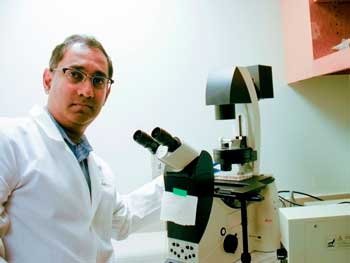 University of Alabama at Birmingham School of Optometry research associate Roy Joseph, Ph.D., was recently recognized as having one of the top 3 percent of abstracts submitted at the Association for Research in Vision and Ophthalmology annual meeting.
University of Alabama at Birmingham School of Optometry research associate Roy Joseph, Ph.D., was recently recognized as having one of the top 3 percent of abstracts submitted at the Association for Research in Vision and Ophthalmology annual meeting.
Joseph’s abstract, Generation of Induced Pluripotent Stem Cells from Normal and Keratoconus Corneal Fibroblasts using Viral- and Non-Viral Methods, was named an ARVO 2014 Emerging Trends and Hot Topics abstract, representing the newest and most innovative research being conducted in the various specialties.
The research is focused on keratoconus, a disease of the cornea that causes visual degradation and the inability to focus a clear image onto the retina; it can eventually require corneal transplantation, which Joseph says occurs in one in 2,000 people.
Joseph explains that corneal tissues are composed of collagen fibers laid in layers, sandwiching keratocyte cells. In culture, keratocytes normally become fibroblasts or scar cells. Joseph believes keratocyte abnormalities play a pivotal role in keratoconus.
"Our research utilizes reprogramming factors inducing these fibroblasts into induced pluripotent stem cells, or iPSCs, by viral and non-viral methods. Using a variety of agents, these stem cells are then converted back into true corneal keratocytes,” Joseph said. “This conversion in tissue culture allows for a wealth of studies to further unravel the cellular mysteries in keratocytes from keratoconus.”
Joseph, who works in the laboratory of Om P. Srivastava, Ph.D., says his work is a “disease-in-a-dish” approach that could be a source for better understanding of corneal disease progression and correcting the genetic defects from this disease.